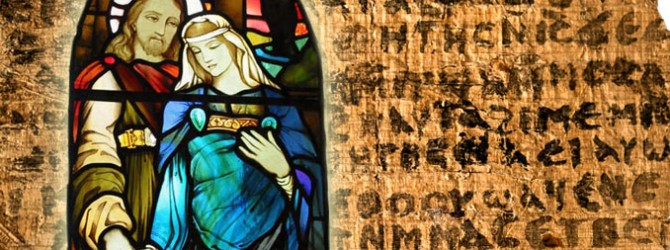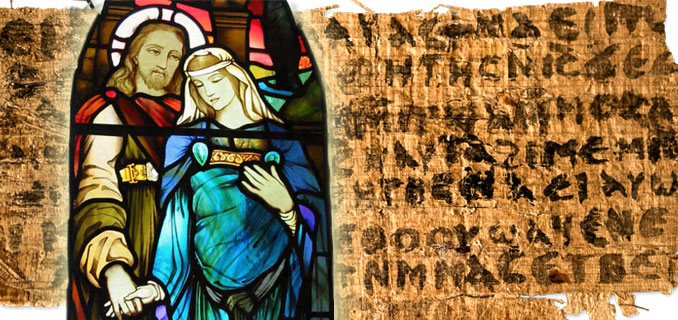
Did Jesus have a wife?
 The Web is by now awash with stories of an ancient text in which Jesus says ‘my wife’. The story which broke yesterday in the New York Times and some other sources, is being carried today by outlets too numerous to list. Some of the reporting is responsible, but not all. Consider this extract from The Daily Mail:
The Web is by now awash with stories of an ancient text in which Jesus says ‘my wife’. The story which broke yesterday in the New York Times and some other sources, is being carried today by outlets too numerous to list. Some of the reporting is responsible, but not all. Consider this extract from The Daily Mail:
“If genuine, the document casts doubt on a centuries old official representation of Magdalene as a repentant whore and overturns the Christian ideal of sexual abstinence.”
We are of course in a context where there is so much ignorance of basic facts about Christianity that even when the media properly relay facts they get completely distorted and misunderstood in popular perception. This can be seen in the way derivative media put spin on the story and in the online comments below the news items.
Here we try to establish a few facts.
The scholarly article upon which almost all knowledge of the fragment is based is here.
What do we know from this?
What’s in a name?
First, let’s start with the name. The scholar involved, Professor Karen King of Harvard, has decided to call this The Gospel of Jesus’s Wife. However, it might more appropriately be named The Fragment about Jesus’s Relations, since there’s no evidence that it was called a gospel and the text mentions at least two family members. Of course, such a name would not generate the same publicity. Despite this unfortunate choice of name, Professor King is to be commended for publishing a good photograph and detailed scholarly analysis of the fragment simultaneously with the press release. Usually in the case of controversial text the media hype comes long before the availability of the text.
Genuine or forgery?
Professor King has provided pictures of the papyrus, but it is not publicly known who owns it, or where it came from. If genuine, it almost certainly came from Egypt because that is where papyri like this are found.
Because it was not found in situ it is obviously possible to doubt its genuineness. Scholars at Tyndale House think that, on the basis of the limited evidence currently available, it is possible it is genuine, though there are good reasons for scepticism – see the comments of Dr Christian Askeland, an expert in Coptic manuscripts here.
What about date?
It is written in Coptic, the language of Egypt which descended from the even earlier language of the Hieroglyphs. Coptic is Egyptian written in the Greek alphabet with a few extra letters. Because Coptic was only emerging as a written language in the third century and papyrus went out of use in the seventh century the 8 cm x 4 cm fragment has to be dated some time from the third to the seventh century and the scholars involved with this fragment have stated that it is fourth century on the basis of the handwriting.
Since we have virtually no firmly dated Coptic handwriting, this date is just an educated guess.
Then we turn to the date of the contents. Here Professor King puts the text in the late second century, but all that we really know is that the text is at least as old as the manuscript.
The papyrus at the centre of the publicity
What does it say?
This is King’s translation of the text, with square brackets used where the text does not survive:
FRONT:
1 ] “not [to] me. My mother gave to me li[fe…”
2 ] The disciples said to Jesus, “.[
3 ] deny. Mary is worthy of it[
4 ]……” Jesus said to them, “My wife . .[
5 ]… she will be able to be my disciple . . [
6 ] Let wicked people swell up … [
7] As for me, I dwell with her in order to . [
8] an image [
BACK:
1 ] my moth[er
2 ] three [
3 ] … [
4 ] forth which … [
5 ] (illegible ink traces)
We believe this to be a largely reliable translation. But is it evidence that Jesus had a wife? The answer is an emphatic ‘no’. Not even Karen King is claiming that it is, though it’s inevitable that some of the news outlets will present it otherwise.
What we have here is a typical sort of text which arose after Christianity had become very popular and when derivatives of Christianity began to emerge. The language of the text is very similar to the Gospel of Thomas, sayings 101 and 114, and the Gospel of Thomas saying 101 shows influence of Luke 14:26, as the Gospel of Thomas does elsewhere. This way of speaking belongs to the mid-second century or later, in other words generations later than the books of the New Testament.
We asked Dr Simon Gathercole, an expert on apocryphal gospels and Senior Lecturer in New Testament in the University of Cambridge, for his comments. (See his analysis below).
The Gospel of Jesus’ Wife
This piece of papyrus has been authenticated by two reputable scholars, Profs. Roger Bagnall and AnneMarie Luijendijk. There are doubts, however, which have been raised about its authenticity, especially by scholars at the International Congress of Coptic Studies in Rome, where there is a good deal of scepticism. This is a tiny fragment of text, but which has something unprecedented in it, namely a reference to Jesus addressing someone as “My wife….”:
1 ] not. My mother has given me [life]
2 ] The disciples said to Jesus, [
3 ] deny. Mary is worthy of it [
4 ] Jesus said to them, “My wife… [
5 ] She will be able to be a disciple to me, and [
6 ] Let evil man ??? […
7 ] As for me, I am with her because [
] an image [
Relation to other gospels
What is interesting about the relation of this fragment to other gospels is that it is closest to the Gospel of Thomas:
Line 1:
Gos. Thom. 101.3:
My mother has given me [life].
My true Mother has given me life.
Line 3:
Gos. Thom. 114.1:
Mary is worthy of it
Simon Peter said to them, ‘Let Mary come out from us, because women are not worthy of life.’
Line 5:
Gos. Thom. 101.1-2: She will be able to be a disciple to me
Whoever does not hate his father and his mother as I do cannot be a disciple to me. And whoever does not love his Father and his Mother as I do cannot be a disciple of mine.
There is obviously ongoing debate here about the role of Mary. What is not paralleled elsewhere is that Jesus addresses someone – probably Mary Magdalene – as his wife. There are two possible implications of this:
1. This could be like the special relationship that Mary Magdalene and Jesus have in the Gospel of Philip. There, Mary is closer to Jesus than the other disciples are, as Mary Magdalene is an important symbol: the relationship between Jesus and Mary Magdalene is an allegory of the soul’s meeting with God in the bridal chamber, i.e. salvation.
2. It could reflect debates about marriage and sex in the early church. Tertullian (c. 200, the time of this fragment), discussed marriage a lot, in particular re-marriage after death of a spouse (which he said was wrong), and his view of marriage was that the ideal marriage was without sex. Others at the time, like Clement of Alexandria, report opponents using Jesus’ celibacy as an argument for Christians remaining celibate. Some, he says, “say outright that marriage is fornication and teach that it was introduced by the devil. These arrogant people say that they are imitating the Lord, who neither married nor possessed anything in this world, boasting that they understand the gospel better than others.” (Clement, Stromateis 3.49.1). The use of such a striking motif as Jesus being married obviously had a point to it: it may have been that Jesus’ marriage was invented as a reason to justify marriage.
3. It could be a text like the Gospel of Mary, where Mary has become an alternative channel of revelation. She is given a place very close to Jesus, so that she can be a mouthpiece for an alternative treatment of salvation.
Other references to Jesus in similar relationships
Jesus has female disciples in the canonical gospels, who support his ministry (Luke 8), and who are part of his entourage generally. There is no reference to marriage of any kind, which is striking in a biography. (Suetonius’ Lives of the Caesars, for example, mentions wives and fiancées of all 12 of his subjects.) Other apocryphal gospels develop some of these relationships. So, for example, Salome is a very minor character in the gospels (mentioned only twice, only in Mark’s gospel), but she becomes significant in the Gospel of the Egyptians, and especially in the Gospel of Thomas, where she shares a couch with Jesus: it was a dining couch rather than a bed, but sharing a dining couch was still a louche thing to do, and effectively meant being married or lovers. The Gospel of Philip might refer to Jesus kissing Mary, but the manuscript has some holes in at the key point! In a later text called the Greater Questions of Mary, Jesus even – in front of Mary Magdalene – has sex with a woman whom he has produced out of his side.
Harvard Professor Karen King, who is the person who has been entrusted with the text, has rightly warned us that this does not say anything about the historical Jesus. She is correct that “its possible date of composition in the second half of the second century, argues against its value as evidence for the life of the historical Jesus”. But she is also right that this is a fascinating discovery which offers us a window into debates about sex and marriage in the early church, and the way Jesus could be adapted to play a part in a particular debate, but only if it is genuine.
Simon Gathercole
